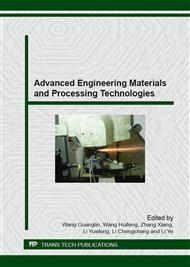p.298
p.303
p.308
p.314
p.320
p.326
p.335
p.341
p.347
Experimental Research on Selective Laser Sintering of Bamboo Flour/Polyamide Hot-Melt Adhensive Blend
Abstract:
Bamboo flour is a kind of a cheap reproducible natural plant powder. The polyamide hot melt adhesive (polyamide) is good bamboo adhesives. The bamboo flour/polyamide blend is prepared through mechanical mixing method. The powder bed preheating temperature of the laser sintering processing and the processing parameters of bamboo flour/polyamide blend are determined through the differential scanning calorimetry method (DSC method) and single layer sintering experiment. The mechanical testing parts are successfully fabricated by selective laser sintering using the bamboo flour/polyamide blend of 25/75 (wt/wt). In this series of experiments, the average tensile strength, flexural strength and impact strength of 5.9Mpa、11.5Mpa and 4.5KJ/m2 are obtained when the laser power is 11W, scan spacing is 0.1mm, the thickness of a layer is 0.1mm and scanning speed is 2000mm/s. The tensile strength and flexural strength of the SLS specimens are improved through wax infiltrating process, while the average impact strength of the wax-infiltrated specimens decreases compared with the SLS specimens processed under the same set of parameters. Bamboo flour/polyamide composite powder is new laser sintering with good forming property and low cost.
Info:
Periodical:
Pages:
320-325
Citation:
Online since:
October 2015
Authors:
Price:
Сopyright:
© 2016 Trans Tech Publications Ltd. All Rights Reserved
Share:
Citation:


